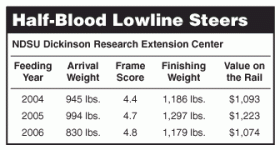TJ
Well-known member
- Joined
- May 15, 2007
- Messages
- 2,036
simtal said:fluffer said:Im not trying to hijack this discussion! ;D
I read and article yesterday that said that "mini" cattle could be the future of our industry. #1 for kids as projects, these cattle would requre less feed there for being less expensive for the kids. #2 for our industry, these cattle will produce more meat in relationship to their size and feed intake when compaired to larger cattle. That makes them more economical and profitable for the feeder. My question, however, is do packers discount these cattle for being smaller?
Fluffer
require less feed? absolutely, more economical? No way jose.
yeah they get discounted, they don't weigh up as much other cattle, nor gain as well or grow as efficiently, mainly due to composition. If you sell on carcass weight your at a disadvantage, plus your gonna get killed on dressing perecent. It maybe easier with a big choice-select spread, but when yield counts (lower cattle prices and tighter spread) its different. Granted, there is an ever increasing trend for smaller high quality beef supplies but, you don't see any of these big yards feeding these types. However that doesn't mean that the cow sector couldn't benefit from some these genetics. just my two cents.
simtal, here is some interesting data fro you to look at...

